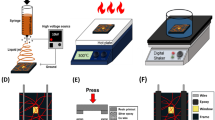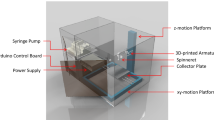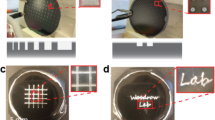Abstract
A simple and low-cost method is suggested to fabricate nanochannels via Near-Field Electrospinning (NFES). In this process, orderly and patterned nanofibers direct-written by NFES are used as sacrificial templates. Well-defined nanochannels are available after the removal process of both sacrificial fibers and material coating over the fibers. The sacrificial fiber, controlled by NFES, dominates the channel geometry. The channel width ranges from 133 nm to 13.54 µm while the applied voltage increases from 1.2 kV to 2.5 kV. Complicated wave-shape and grid pattern channels are presented under a corresponding movement of substrate. This method integrates electrospinning with conventional MEMS fabrication technology and has a potential in micro/nano manufacturing.
Similar content being viewed by others
Explore related subjects
Discover the latest articles, news and stories from top researchers in related subjects.Avoid common mistakes on your manuscript.
1 Introduction
Nanochannels have drawn great interests due to their superior characteristics and promising future in micro/nano-fluidic and electronic devices [1–4]. Many techniques have been developed and extensively reviewed for the fabrication of nanochannels [2–6]. High-resolution lithography (such as electron beam [7], focused ion beam [8], laser [9], etc.) as well as various template/molding strategies are commonly used, however, require elaborate operations and expensive apparatus. Simple, low-cost fabrication methods are desired for nanochannels in the rapid development of micro/nano devices. Nanoimprint technology provides a lithography-free manner with high throughput, low cost, and high resolution [10], but typically requires high-resolution lithography for the fabrication of template.
Recent progresses have demonstrated a simple and low-cost method to fabricate nanochannels by electrospinning nanofibers as sacrificial templates [11–13]. Czaplewski et al. electrospun oriented nanofibers on a rotating substrate and obtained nanochannels by thermal removal of these nanofibers [11]. Ishii et al. fabricated submicron electrode gap by stretching electrospun nanofiber as a show mask [13]. However, these approaches are limited by lacking the controllability of fibers deposition thus cannot well integrate with conventional micro/nano manufacturing processes.
Our previous works have shown that Near-Field Electrospinning (NFES) is a potential approach to direct-write orderly micro/nanofibers for realizing their engineering applications [14–16]. In this paper, NFES directly deposited nanofibers as the sacrificial template patterning on a substrate. Following a coating process of channel material and a subsequent sacrificial nanofibers removal, orderly nanochannels as well as complex patterns took shape for further micro/nano-electronic and fluidic devices fabrication.
2 Experimental details
2.1 Materials
Polyethylene oxide (PEO, M n =300,000) was purchased from Dadi Fine Chemical Co., Ltd., China. Ethanol was purchased from Sinopharm Chemical Reagent Co., Ltd., China. All these materials were used without any further purification. The PEO was dissolved in a mixed solvent of deionized water and ethanol (v/v=60/40), then stirred at room temperature for 24 hours to ensure a homogeneous mixture before experiments. The concentration, viscosity, surface tension, and conductivity of PEO solution were 18 wt%, 80.5 mPa s, 38 mN/m, and 53.3 µs/cm, respectively.
2.2 NFES setup
NFES setup is shown in Fig. 1a, where the anode of high-voltage power supply (DW-P403-1AC, Dongwen) connected to probe spinneret and the cathode connected to silicon substrate. The probe tip was 40 µm in diameter; the probe surface except probe tip had a hydrophobic treatment to keep polymer solution only adhesion on the tip. The spinneret-to-substrate distance was set at 1.5 mm. The substrate was fixed on an XY stage to have a motion speed in the range of 0–200 mm/s.
Under an applied high voltage, a polymer jet would eject and then deposit onto the substrate as a solid fiber with diameters range from tens of nanometers to several micrometers. NFES can direct-write nanofibers in a predesigned pattern by controlling the motion trajectory of XY stage. The NFES process can be visibly operated under a microscope system, which provides an effective aspect for the precise deposition location and real-time monitoring [16].
2.3 Fabrication of nanochannel
Figure 1b shows the schematic diagram of nanochannel formation. The substrate was ultrasonic cleansed before NFES. First, PEO fiber as a sacrificial template was direct-written on the substrate in a predesigned track via NFES. A 30-nm-thick Au layer was then coated as capping layer on the substrate by using a magnetron sputter. Afterward, the Au-coated substrate was ultrasonic cleaned in chloroform for 15 minutes to dissolve the fiber. The ultrasonic frequency and power were 40 kHz and 80 W, respectively. The Au layer coated over polymeric fiber can be removed by the ultrasonic lift-off process. After that, a channel was formed on the substrate.
2.4 Characterization
Both fibers and channels were characterized by scanning electron microscope (SEM) (LEO 1530 Gemini) and optical microscopy system (Mitutoyo). Energy dispersive X-ray detector (EDX) was also utilized to examine the polymer removal and channel formation.
3 Results and discussion
NFES imposes the stable jet region close to the spinneret tip to direct-write orderly fibers within a short spinneret-to-collector distance. The advantages of NFES over conventional electrospinning lie mainly in the precise deposition and complex patterning of fibers. Straight fibers can be generated when the substrate speed is higher than electrospinning deposition rate. Figure 2a demonstrates a straight and chaotic fiber direct-written at a fixed applied voltage of 1.4 kV. The straight fiber was obtained at a substrate motion speed of 150 mm/s, while the chaotic one was formed with a substrate speed of 100 mm/s. Figure 2b shows the 140-µm-length channel obtained via the straight fiber presented in Fig. 2a. The silicon substrate was pre-treated before NFES by using conventional photoresist technique, as described in Online Resource 1, to define a 140-µm-length Au coating area for the deposition of NFES fiber and definition of channel length.
In the experiments, the polymer solution is supplied in a manner analogous to that of dip-pen by dipping the spinneret probe into polymer solution. The polymer droplet attached to the probe tip is about 50 to 60 µm in diameter and the electrospinning process can persist for 6 to 10 seconds every dipping. The repeatable operation and near-field stable jetting of NFES result in a uniform sacrificial fiber and a consequent well-defined channel as shown in Fig. 3a. Owing to the hydrophobic treatment on the spinneret, the polymer solution can be reloaded in a same volume, contributes to the formation of uniform fibers in each repetition of NFES process.
(a) SEM image of a well-defined nanofiber. (b) A broken nanofiber remained on the substrate under an insufficient ultrasonic cleaning time (10 minutes). The channel width is almost equal to the nanofiber diameter. (c) EDX spectrums of nanochannel bottom and Au layer beside the channel. (d) A relationship between channel width and applied voltage in NFES
The channel pattern is mainly determined by the sacrificial fiber obtained from NFES. Figure 3b shows a broken nanofiber remained on the substrate due to an insufficient ultrasonic cleaning time (10 minutes); the channel width is almost equal to the fiber diameter. Furthermore, the spectrum analysis by EDX (Fig. 3c) confirms the formation of channel. The spectrums mainly show Si and O peaks in the channel bottom, i.e. silicon substrate, while Au peaks were obviously in the coating layer. This result indicates that the polymer fiber has been removed completely from the channel and the Au never caves onto the channel.
Figure 3d presents a relationship between channel width and applied voltage. Twenty straight channels were fabricated under each applied voltage to calculate the average channel widths and standard deviations. The average channel width ranged from 133 nm to 13.54 µm with the applied voltage varied from 1.2 kV to 2.5 kV. These data show that the channel width increases with increasing applied voltage and fine channel as small as tens nanometers is available via proper NFES process.
Figure 4 demonstrates the SEM images of smooth and uniform channels. Two aligned straight nanochannels with widths of 135 nm and 137 nm are presented in Fig. 4a, where the applied voltage was 1.2 kV. A larger nanochannel with 781-nm-width was formed when the applied voltage increased to 1.5 kV (Fig. 4b). Figure 4c shows a 1.5-µm-width wave channel (at the applied voltage of 1.8 kV) and a 750-nm-width straight channel (at the applied voltage of 1.5 kV) obtained on one substrate. The wave channel was fabricated under a sine movement of substrate carried by the XY stage. The velocity of XY stage was set at 150 mm/s. A complex grid channels were further fabricated under a precise control shown in Fig. 4d, where the channel widths were about 800 nm and the spaces between channels were 100 µm. The straight and arc channels demonstrate the ability to prepare a complicated channel pattern via NFES, while the accuracy of channel pattern rely on the motion of the substrate.
The method of preparing nanochannel via NFES is available to fabricate electrode gaps and fluidic channels in MEMS devices with low cost, wafer scalability, and well-defined feature. The channel length varies from several micrometers to a few meters depending on the feature size of sacrificial fiber and the consequent coating pattern. In this work, for instance, a maximum channel length is about 1.5 meters under a substrate velocity of 150 mm/s, as the polymer solution at one dipping can electrospin fibers for 10 seconds maximally; a certain channel length shorter than that of sacrificial fiber can be achieved by adjusting the length of coating pattern, i.e., 140-µm-width shown in Fig. 2b.
(a) Two aligned nanochannels with widths of 135 nm and 137 nm. The applied voltage for NFES is 1.2 kV. (b) A 781-nm-width nanochannels under an applied voltage of 1.5 kV. (c) A 1.5-µm-width wavy channel and a 750-nm-width straight channel fabricated on one substrate. The applied voltages are 1.8 kV and 1.5 kV, respectively. (d) A grid channel pattern with a channel space of 100 µm. The applied voltage is 1.5 kV and the fiber diameters are approximate 800 nm
4 Conclusions
In this work, we demonstrate a simple and versatile method to fabricate nanochannels via NFES without the application of high-resolution lithography tools. Polymer fiber, as a sacrificial template, is direct-written by NFES; the channel is available after a removal of channel material coat over the fiber by an ultrasonic lift-off process. The size and shape of the channel are compatible with ones of the fiber controlled by NFES process parameters. Experimentally, channel widths ranged from 133 nm to 13.54 µm when the applied voltage varied from 1.2 to 2.5 kV. A precise grid pattern and a wavy channel are fabricated under a corresponding substrate movement. This method couples electrospinning with conventional lithographic and fabrication method, opens up a new and low-cost process in micro/nano manufacturing.
References
J.C.T. Eijkel, A. van den Berg, Microfluid. Nanofluid. 1, 249 (2005)
P. Abgrall, N.T. Nguyen, Anal. Chem. 80, 2326 (2008)
R. Chantiwas, S. Park, S.A. Soper, B.C. Kim, S. Takayama, V. Sunkara, H. Hwang, Y.K. Cho, Chem. Soc. Rev. 40, 3677 (2011)
T. Li, W.P. Hu, D.B. Zhu, Adv. Mater. 22, 286 (2010)
D. Mijatovic, J.C.T. Eijkel, A. van den Berg, Lab Chip 5, 492 (2005)
A.A. Tseng, A. Notargiacomo, T.P. Chen, J. Vac. Sci. Technol. B 23, 877 (2005)
C. Vieu, F. Carcenac, A. Pepin, Y. Chen, M. Mejias, A. Lebib, L. Manin-Ferlazzo, L. Couraud, H. Launois, Appl. Surf. Sci. 164, 111 (2000)
L.D. Menard, J.M. Ramsey, Nano Lett. 11, 512 (2011)
A. Pena, Z.B. Wang, D. Whitehead, L. Li, Appl. Phys. A, Mater. Sci. Process. 101, 287 (2010)
S.Y. Chou, P.R. Krauss, P.J. Renstrom, Science 272, 85 (1996)
D.A. Czaplewski, J. Kameoka, R. Mathers, G.W. Coates, H.G. Craighead, Appl. Phys. Lett. 83, 4836 (2003)
L.M. Bellan, E.A. Strychalski, H.G. Craighead, J. Vac. Sci. Technol. B 26, 1728 (2008)
Y. Ishii, H. Sakai, H. Murata, Thin Solid Films 518, 647 (2009)
D.H. Sun, C. Chang, S. Li, L.W. Lin, Nano Lett. 6, 839 (2006)
G.F. Zheng, W.W. Li, X. Wang, D.Z. Wu, D.H. Sun, L.W. Lin, J. Phys. D, Appl. Phys. 43, 415501 (2010)
H. Wang, G.F. Zheng, W.W. Li, X.A. Wang, D.H. Sun, Appl. Phys. A, Mater. Sci. Process. 102, 457 (2011)
Acknowledgements
The authors gratefully acknowledge the support from the National Natural Science Foundation of China (No. 51035002, No. 51105320) and Fundamental Research Funds for the Central Universities (No. 2010121039).
Author information
Authors and Affiliations
Corresponding authors
Electronic Supplementary Material
Below is the link to the electronic supplementary material.
Rights and permissions
About this article
Cite this article
Wang, X., Zheng, G., Xu, L. et al. Fabrication of nanochannels via near-field electrospinning. Appl. Phys. A 108, 825–828 (2012). https://doi.org/10.1007/s00339-012-6975-6
Received:
Accepted:
Published:
Issue Date:
DOI: https://doi.org/10.1007/s00339-012-6975-6








